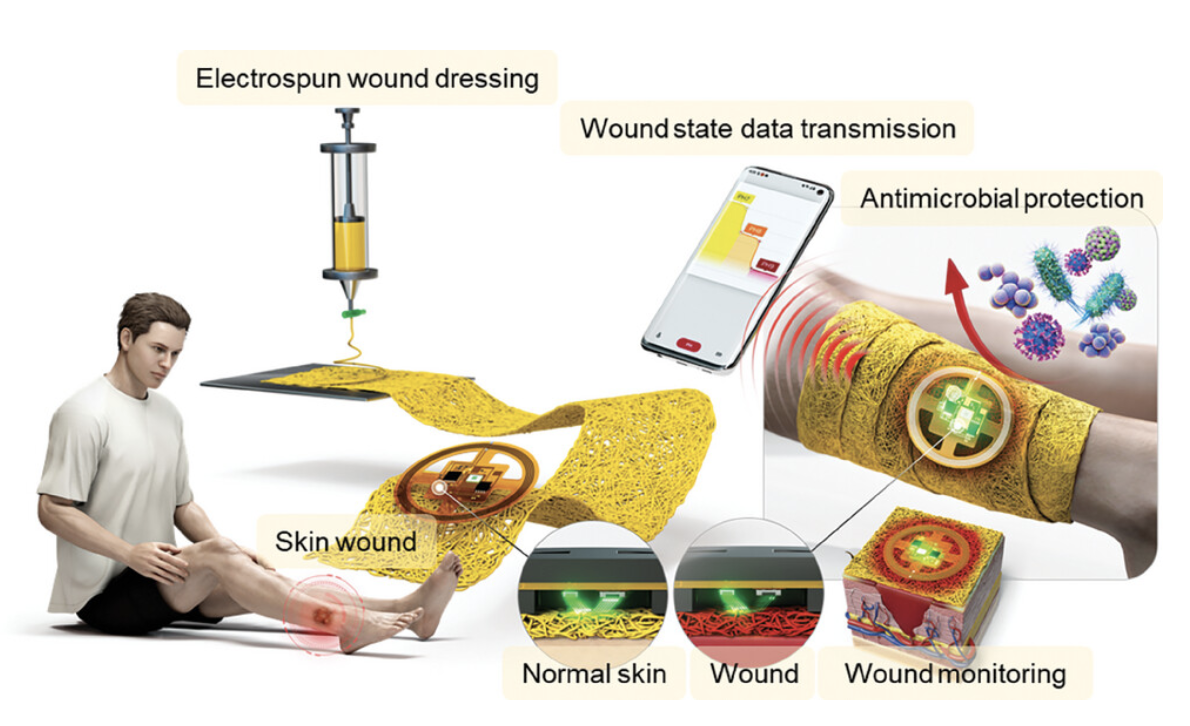Prof. Inkyu Park’s group at KAIST has developed an innovative colorimetric wound dressing integrated with wireless, battery-free optoelectronic sensors. This dressing, fabricated through an electrospinning process, utilizes curcumin and polycaprolactone (C-PCL). Notably, the colorimetric wound dressing undergoes color changes based on pH levels. Moreover, its colorimetric pH sensing capabilities facilitate wound state monitoring, as changes in wound pH levels indicate wound deterioration. Additionally, the color change of the developed dressing is not only visually observable but also quantitatively detectable through the integration of a wireless, battery-free optoelectronic sensor. This allows even layperson patients without specialized knowledge to detect and interpret the color change accurately. The study was published on 14 March, 2024 (Wireless, Battery-Free, Optoelectronic Diagnostic Sensor Integrated Colorimetric Dressing for Advanced Wound Care. Adv. Funct. Mater. 2024, 2316196.).
“We expect that the advanced colorimetric wound dressings and optoelectronic sensors we’ve developed will significantly enhance wound care and protection for patients across the general population,” said Inkyu Park, the corresponding author and a professor in the Department of Mechanical Engineering and the KAIST Institute for the NanoCentury (KINC) at KAIST.
The dressing’s antimicrobial properties and breathability are essential for both wound protection and monitoring. The abundant polyphenols in curcumin offer outstanding resistance against gram-negative and gram-positive bacteria, contributing to the material’s antimicrobial efficacy. This helps prevent wound dehiscence and scarring. Moreover, the exceptional breathability of the electrospun fibers facilitates the continuous circulation of harmful gases away from the wound site, promoting optimal wound healing. The multi-functional wound dressing can overcome various wound deterioration scenarios.
“While all of the broadly protective nAbs were discovered from COVID-19 patients or vaccinated individuals, D27LEY was discovered and developed via a computational antibody design. This suggests that our approach can also be used as a general method for developing mAbs with ultra-potent binding affinities for a given antigen,” Prof. Park said.
“Through observing how the color of blood affects dressing color changes, our advanced wound care system can effectively differentiate between bleeding and wound deterioration. This is supported by identifying changes in the color of the C-PCL dressing, which are distinct from those caused by blood, providing appropriate information regarding the patient’s condition and facilitating timely intervention,” said the first author Seokjoo Cho and Ji-Hwan Ha, graduate students in the Department of Mechanical Engineering at KAIST. This work aims to alleviate the burden on medical staff and enhance the efficiency of wound care by providing timely and accurate diagnosis. By facilitating early detection and intervention through this advanced wound management system, the authors aim to contribute to the crucial “golden time” for proper diagnosis, ultimately improving patient outcomes and quality of care.
This work was supported by a National Research Foundation of Korea (NRF) grant funded by the Korean government (MSIT) Project Number: 2021R1A2C3008742); and the Technology Innovation Program (Development of Heterogeneous Multi-Sensor Micro-System Platform) funded by the Ministry of Trade, Industry & Energy (MOTIE, Korea) (Project Number: 00144157); the Basic Research Program of Korea Institute of Machinery and Materials (KIMM), (Project Number: NK248B); and an Alchemis Project grant funded by Korea Evaluation Institute of Industrial Technology (KEIT) an the Korean government (MOTIE) (Project Number: 1415179744, 20019169).

Prof. Inkyu Park*, Dr. Jun-Ho Jeong*, Mr. Seokjoo Cho, Mr. Ji-Hwan Ha Dept. of Mechanical Engineering, KAIST
E-mail: inkyu@kaist.ac.kr
Homepage: http://mintlab1.kaist.ac.kr






